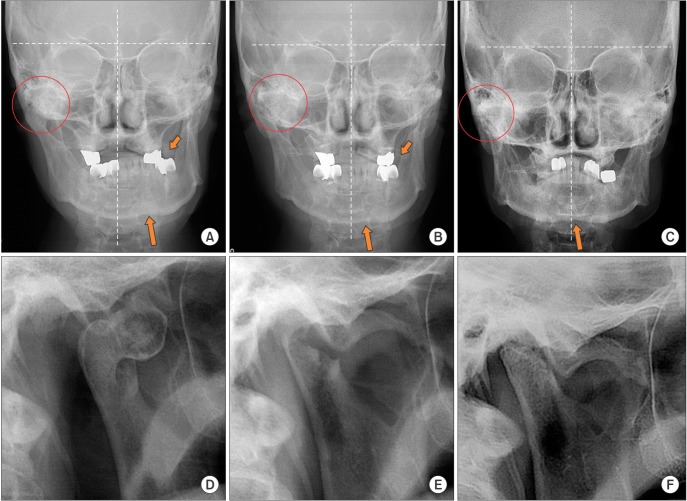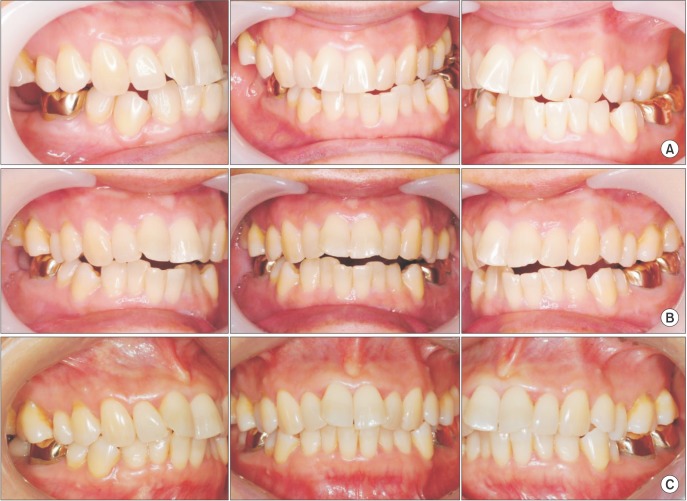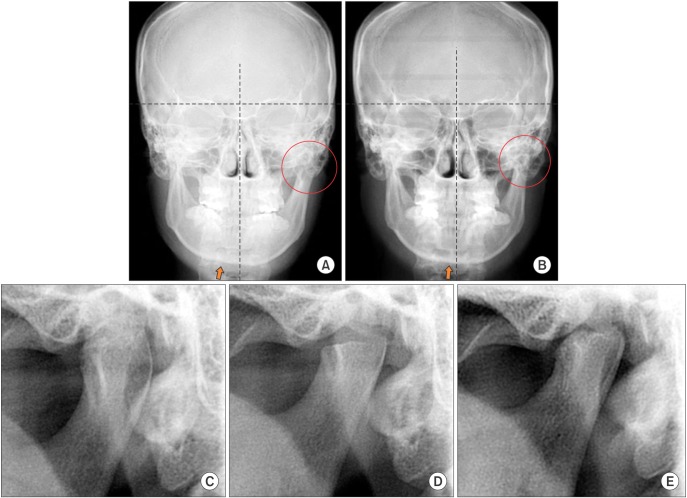J Korean Assoc Oral Maxillofac Surg.
2015 Oct;41(5):259-264. 10.5125/jkaoms.2015.41.5.259.
Conservative condylectomy alone for the correction of mandibular asymmetry caused by osteochondroma of the mandibular condyle: a report of five cases
- Affiliations
-
- 1Department of Oral and Maxillofacial Surgery, Gangnam Severance Hospital, Yonsei University College of Dentistry, Seoul, Korea. omshuh@yuhs.ac
- KMID: 2070440
- DOI: http://doi.org/10.5125/jkaoms.2015.41.5.259
Abstract
- We describe our experience with conservative condylectomy for the correction of facial asymmetry in five patients with osteochondroma of the mandibular condyle. All five patients presented with malocclusion and facial asymmetry, which are common clinical findings of osteochondroma involving the mandibular condyle. We performed conservative condylectomy without additional orthognathic surgery for all five patients, preserving the vertical height of the condylar process as much as possible. Following surgery, intermaxillary traction using a skeletal anchorage system with rubber elastics was performed on all patients to improve occlusion, and, when necessary, additional minimal orthodontic treatment was performed. The mean follow-up period was 42 months. At the last follow-up visit, all patients exhibited satisfactory facial symmetry and remodeling of the remaining condyle, with stable health and no signs of recurrence. In conclusion, conservative condylectomy alone, without subsequent orthognathic surgery, is adequate for the restoration of facial symmetry and the preservation of vertical condylar height in select patients with condylar osteochondroma.
MeSH Terms
Figure
Reference
-
1. Roychoudhury A, Bhatt K, Yadav R, Bhutia O, Roychoudhury S. Review of osteochondroma of mandibular condyle and report of a case series. J Oral Maxillofac Surg. 2011; 69:2815–2823. PMID: 21367506.
Article2. Wolford LM, Mehra P, Franco P. Use of conservative condylectomy for treatment of osteochondroma of the mandibular condyle. J Oral Maxillofac Surg. 2002; 60:262–268. PMID: 11887135.
Article3. Forssell H, Happonen RP, Forssell K, Virolainen E. Osteochondroma of the mandibular condyle. Report of a case and review of the literature. Br J Oral Maxillofac Surg. 1985; 23:183–189. PMID: 3159417.
Article4. Holmlund AB, Gynther GW, Reinholt FP. Surgical treatment of osteochondroma of the mandibular condyle in the adult. A 5-year follow-up. Int J Oral Maxillofac Surg. 2004; 33:549–553. PMID: 15308253.5. Li H, Hu J, Luo E, Zhu S, Li J. Treatment of osteochondroma in the mandibular condyle and secondary dentofacial deformities using surgery combined with orthodontics in adults. J Oral Maxillofac Surg. 2014; 72:2295–2317. PMID: 24856953.
Article6. Wolford LM, Movahed R, Dhameja A, Allen WR. Low condylectomy and orthognathic surgery to treat mandibular condylar osteochondroma: a retrospective review of 37 cases. J Oral Maxillofac Surg. 2014; 72:1704–1728. PMID: 24997022.
Article7. Yang JY, Leem DH. Surgical treatment of osteochondroma on the mandibular condyle through intraoral approach: case report. J Korean Assoc Maxillofac Plast Reconstr Surg. 2012; 34:349–356.8. de Melo WM, Pereira-Santos D, Sonoda CK, de Moura WL, de Paulo-Cravinhos JC. Conservative condylectomy for management of osteochondroma of the mandibular condyle. J Craniofac Surg. 2013; 24:e209–e211. PMID: 23714962.
Article9. Santos GS, Gomes JB, de Sousa Maia S, Bermejo PR, Shinohara EH, Sonoda CK, et al. Using conservative condylectomy for management of a large osteochondroma of the mandibular condyle with 6-year follow-up. J Craniofac Surg. 2014; 25:e102–e104. PMID: 24469370.
Article10. Kim HS, Lee SH, Youn T, Kim HG, Huh JK. Anterior open bite with temporomandibular disorders treated with intermaxillary traction using skeletal anchorage system. J Korean Assoc Oral Maxillofac Surg. 2012; 38:284–294.
Article11. Karras SC, Wolford LM, Cottrell DA. Concurrent osteochondroma of the mandibular condyle and ipsilateral cranial base resulting in temperomandibular joint ankylosis: report of a case and review of the literature. J Oral Maxillofac Surg. 1996; 54:640–646. PMID: 8632254.
Article12. Peroz I, Scholman HJ, Hell B. Osteochondroma of the mandibular condyle: a case report. Int J Oral Maxillofac Surg. 2002; 31:455–456. PMID: 12361086.
Article13. Ribas Mde O, Martins WD, de Sousa MH, Zanferrari FL, Lanzoni T. Osteochondroma of the mandibular condyle: literature review and report of a case. J Contemp Dent Pract. 2007; 8:52–59. PMID: 17486187.14. Iizuka T, Schroth G, Laeng RH, Lädrach K. Osteochondroma of the mandibular condyle: report of a case. J Oral Maxillofac Surg. 1996; 54:495–501. PMID: 8600267.
Article15. Martinez-Lage JL, Gonzalez J, Pineda A, Alvarez I. Condylar reconstruction by oblique sliding vertical-ramus osteotomy. J Craniomaxillofac Surg. 2004; 32:155–160. PMID: 15113573.
Article
- Full Text Links
- Actions
-
Cited
- CITED
-
- Close
- Share
- Similar articles
-
- Surgical Treatment of Osteochondroma on the Mandibular Condyle through Intraoral Approach: Case Report
- Conservative resection of osteochondroma on mandibular condyle: A case report
- OSTEOCHONDROMA OF THE MANDIBULAR CONDYLE AND ACCOMPANYING FACIAL ASYMMETRY: REPORT OF A CASE
- Bimaxillary orthognathic surgery and condylectomy for mandibular condyle osteochondroma: a case report
- Osteochonrdoma Of The Mandibular Condyle: A Case Report





